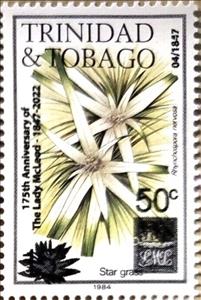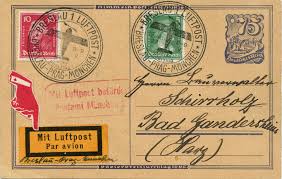Stamp: Star grass (Rhynchospora nervosa) Overprinted (Trinidad and Tobago 2022)
Star grass (Rhynchospora nervosa) Overprinted (Trinidad and Tobago 2022)
01 July (Trinidad and Tobago ) within release 2022 Commemorative Overprints goes into circulation Stamp Star grass (Rhynchospora nervosa) Overprinted face value 50 Trinidad and Tobago cent
| Stamp Star grass (Rhynchospora nervosa) Overprinted in catalogues | |
|---|---|
| Colnect codes: | Col: TT 2022.07.00-02 |
Stamp is vertical format.
Stamp overprinted "175th Anniversary of The Lady McLeod - 1847-2022" and image of stampAlso in the issue 2022 Commemorative Overprints:
- Stamp - Columnea scandens Overprinted for Platinum Jubilee face value 50;
- Stamp - Star grass (Rhynchospora nervosa) Overprinted face value 50;
Stamp Star grass (Rhynchospora nervosa) Overprinted it reflects the thematic directions:
A flower, sometimes known as a bloom or blossom, is the reproductive structure found in plants that are floral (plants of the division Magnoliophyta, also called angiosperms). The biological function of a flower is to effect reproduction, usually by providing a mechanism for the union of sperm with eggs. Flowers may facilitate outcrossing (fusion of sperm and eggs from different individuals in a population) or allow selfing (fusion of sperm and egg from the same flower). Some flowers produce diaspores without fertilization (parthenocarpy). Flowers contain sporangia and are the site where gametophytes develop. Many flowers have evolved to be attractive to animals, so as to cause them to be vectors for the transfer of pollen. After fertilization, the ovary of the flower develops into fruit containing seeds. In addition to facilitating the reproduction of flowering plants, flowers have long been admired and used by humans to beautify their environment, and also as objects of romance, ritual, religion, medicine and as a source of food.
Flora is the plant life occurring in a particular region or time, generally the naturally occurring or indigenous—native plant life. The corresponding term for animal life is fauna. Flora, fauna and other forms of life such as fungi are collectively referred to as biota. Sometimes bacteria and fungi are also referred to as flora, as in the terms gut flora or skin flora.
Postal history is the study of postal systems and how they operate and, or, the study of the use of postage stamps and covers and associated postal artifacts illustrating historical episodes in the development of postal systems. The term is attributed to Robson Lowe, a professional philatelist, stamp dealer and stamp auctioneer, who made the first organised study of the subject in the 1930s and described philatelists as "students of science", but postal historians as "students of humanity". More precisely, philatelists describe postal history as the study of rates, routes, markings, and means (of transport).



